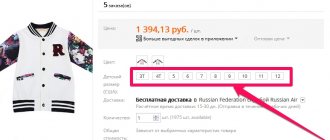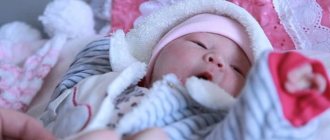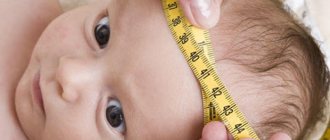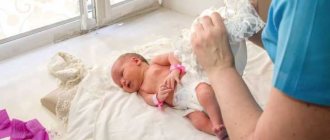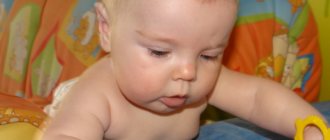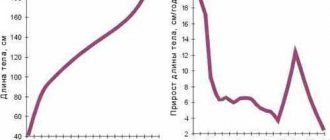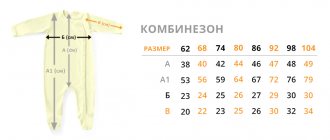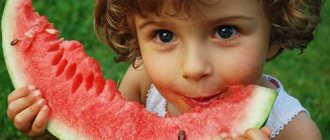Most people are unlikely to be able to answer correctly when asked what size hat they have. Some people don’t even know clothing sizes very well, let alone hats and caps. Moreover, hats in our country are worn mainly in winter, and even then not by everyone. But when a child appears in the family, questions about clothing sizes for him become more relevant than ever. Many parents who have had their first baby and have no experience yet are faced with the following question: how to determine the size of hats for children? After all, this is a very important part of a child's wardrobe.
Head circumference in children: table for hats
Rules for measuring head circumference
- Head circumference. To measure the girth, you will need ordinary sewing tape, which is used to create a pattern. So, sit your child as comfortably as possible, take the tape and wrap it tightly around the baby's head.
Table of size correspondence to head circumference
- Try to do everything so that it does not sag anywhere and does not squeeze the skin anywhere. Measurements should be taken just above the eyebrow line. If you don't have a special tape, you can always use regular thread. It’s just that in this case you will first have to measure its length with a ruler and only then look in the table to see what size your child’s head circumference corresponds to.
- If you want to get the most accurate size for your future new item, then take measurements in several stages. Move the tape a little up and then down and calculate the average of the data obtained.
Finding out the parameters of the headdress
Now we will give some tips regarding what size cap to buy for a newborn or older child. First of all, we must find out the head circumference of our “client”. We measure it with a measuring tape, drawing it slightly above the eyebrows and along the highest part of the back of the head. We don’t tighten it too much, but we also don’t let it sag. Next, we turn to the numbers above and see which line the resulting numbers match.
A complete classification of types of fabrics is on our website; compare natural and artificial materials.
And one more small clarification. In this article we talked about Russian markings. However, there are products on sale with letter markings. How to determine the size of a children's hat in this case? Let's just check this sign.
| Head circumference | 40-43 | 44-46 | 47-49 | 50-52 | 53-55 | 56-58 |
| Number of months, years | 3 months | 6-9 months | 12-24 months | 3 years | 4-5 l. | 10-12 l. |
| Marking | XXS | XS | S | M | L | XL |
Watch the video:
How to measure your head size for a hat?
Taking measurements to buy a hat
- But in order to correctly determine the size of the hat, one head circumference is not enough. If you want your child to wear the cap you bought him for as long as possible, then in addition to the girth, measure other parameters. To have a complete idea of what you will be buying, you also need to know the exact depth of the product (it is also the height of the cap).
- To measure the depth of the cap, you also need to know the circumference of your head. To obtain these indicators, the head circumference must be divided by three and subtract 3 millimeters from the resulting number. By comparing all this data you will find out the correct size of headgear for your child.
- Yes, and remember, if you are choosing a hat for a baby who has just been born, you can take the product a little more than necessary. Small children grow very quickly, so in just a few weeks the child’s head will increase in size, and the hat will fit him just right.
Terminology and types of hats
You may be surprised, but there is a whole “Big Dictionary of Headdresses”, a significant part of which is still in use. Even the seemingly simplest caps or berets have dozens of options and sub-options. It’s difficult to understand all this in detail, and it’s not worth it. Let's just try to highlight the main types of children's hats in order, firstly, to navigate their endless variety, and secondly, to simplify our life when searching for and choosing a hat in an online store.
A cap
The constant leader is the hat, a collective term that in the vast majority of cases means a traditional headdress with a more or less loose cut. It may vary the material, the thickness of the fabric, the design may change slightly (for example, the presence or absence of a pom-pom), but the general features are almost always the same and upon request “boys hat” you will receive a set of items of approximately the same style.
A classic hat without restrictions may contain various prints, patterns, ties, buttons, rhinestones... Of course, a coarse knitted children's hat with a pompom looks a little different than a finely knitted model with patterns and rhinestones, but nevertheless, both options are a hat, aka hat.
Beanie
A beanie hat that fits tightly to the head was once the privilege of working people, athletes, and climbers. But this practical model was quickly appreciated by young people, always hungry for fresh ideas, and then everyone else caught up.
The origin of the term is still debated, ranging between the French "bejaunus" (yellowmouth) and the English "bean" (bean). Despite the simplicity of the design, the beanie is fashionable, fresh and practical, because one of the advantages of the traditional beanie hat is the fact that it takes up extremely little space - no more than a sock, and will fit into any pocket or even pocket.
Baseball cap
Oddly enough, the baseball cap actually has a direct connection with the truly American sport of baseball. In the 50s of the last century, this sports cap with a characteristic visor that protected the players’ eyes from the sun was introduced as an accessory and element of the baseball player’s uniform. Almost immediately, fans acquired similar models, and very quickly the baseball cap ceased to be exclusively a sports headdress.
We recommend reading: TOP 7 pacifiers: choosing the best pacifier for a child, a detailed analysis of individual pacifier models
Everyone liked the design, and when it turned out that various designs could be applied to a baseball cap, a real epidemic began. After all, these caps have become advertising products - along with keychains and pens. Now there are so many options that even a winter insulated baseball cap with natural fur won’t really surprise anyone.
Panama
The straw hat, which gave this headdress its name, is almost no longer associated with it. But, seeing the familiar narrow brim and thick fabric, “Panama hat” (or “Panama hat”, depending on your taste) immediately comes to mind. In fact, what we used to call a Panama hat is the so-called “bucket”, or bucket hat.
The “bucket” was invented by British farmers at the beginning of the 20th century. Then it became popular among fishermen who appreciated the convenience and comfort. As a fashion accessory, the headdress began its journey after the Vietnam War, where it was part of the equipment of American soldiers.
The model’s convenience, comfort and stable demand have led to the fact that the “bucket” Panama hat is invariably present in the catalogs of almost all fashion brands. Well, a children's Panama hat is an accessory that you can't do without on any summer walk.
How to determine the size of a child's hat from a table?
Determining the size of a hat for a child
- If you want to find out the most accurate size of your child’s hat, then you can use a special table. But in order to get the correct data, you better measure the exact height of your child in advance. Also, when using such tables, you must also take into account the age of your son or daughter. Only the combination of all this data will allow you to get a result that will correspond to the parameters of the child’s headdress.
- Under no circumstances rely on the size charts of little-known brands. As a rule, when making hats, they take into account only the circumference of the head. Moreover, to make their work easier, they simply take the minimum circumference of the child’s skull and make hats, constantly adding 1-2 centimeters to the circumference. Because of this, the indicators in their size chart may not correspond to the baby’s age and dimensions.
- When choosing the size of a child’s hat, it is very important to take into account not only all the parameters described above, but also what season you need it for. If you are planning to buy a cap for the summer, then you can quite easily choose a product that strictly corresponds to the parameters in the table. If you need a warm winter model, then choose hats that are at least 2 millimeters larger than necessary, especially if you plan to wear thinner items under them.
- Do not forget that the indicators in the table are approximate, so if possible, before you decide on a hat, be sure to try it on your baby. If you order a product from an online store, then check if they have the option of returning or exchanging.
Sizes of winter and summer hats for children
It should be noted that the approaches to choosing summer and winter hats are different. After all, in winter, often, especially in the first year of a baby’s life, a thinner cap or cap is worn under the hat. In this case, how to choose a hat for a child? The size of the winter hat should be slightly larger than the circumference of the baby's head. In summer, the hat should correspond to the size of the child, and should not be too big or too small for him. Sometimes on children's items the manufacturer indicates not only the size, but also the recommended age of children for whom this product is suitable. This helps you navigate and make the right choice.
Sizes of hats for newborns by month: table
Sizes of hats for newborns by month
- In the case of newborns, when choosing a hat size, it is a mistake to focus only on the baby’s height. In this case, it is the head circumference that plays the maximum role. Therefore, in order to understand what size headdress your baby needs, you need to measure the circumference of her head, and also find out the exact depth of the product.
- We described how to do all this at the beginning of our article. If you were attentive, you probably remembered that in order to get the exact parameters for the size of the hat, you must also subtract 3 millimeters from the circumference divided by 3. But if you buy a hat made of cotton, then you don’t need to do this. As a rule, after the first wash, cotton items shrink quite noticeably and this can cause the hat to become too small for your baby.
- And if you choose a cap made of acrylic or viscose threads, then the product, on the contrary, may stretch slightly. For this reason, in this case, it is necessary to subtract 3-5 millimeters from the obtained data.
Centile table of head circumference sizes by month/year for girls from 0 to 10 years
| Age | Head circumference | |
| cm | % of body length | |
| Up to 1 month | 34 | 68 |
| 1 month | 36 | 68 |
| 2 months | 38 | 68 |
| 3 months | 40 | 68 |
| 6 months | 43 | 65 |
| 9 months | 45 | 64 |
| 1 year | 46 | 62 |
| 2 years | 48 | 56 |
| 3 years | 49 | 52 |
| 4 years | 50 | 50 |
| 5 years | 50 | 47 |
| 6 years | 50 | 44 |
| 7 years | 51 | 43 |
| 8 years | 51 | 41 |
| 9 years | 51 | 39 |
| 10 years | 51 | 38 |
Deviations from the norm
Serious deviations from normal values may indicate existing pathologies. Let us give an example of several pathological changes in the shape and diameter of the head that are of serious importance.
Otherwise called hydrocephalus or dropsy of the brain. This condition in a child is very easy to notice - the head grows in sharp leaps, while his body remains small and thin. The frontoparietal region is enlarged several times and stands out above the rest of the surface of the head. An unnaturally large fontanel is also striking to an unprofessional eye. Hydrocephalus often occurs in children after intrauterine infections.
Microcephaly, or small skull, is a pathology in which the perimeter of the baby’s skull is smaller than it should be normally, which leads to mental retardation and neurological abnormalities. The cause of microcephaly can be many factors, some of which are: rubella suffered by the mother during pregnancy, toxoplasmosis, Zika fever, etc.
How to measure your hat size?
Hat size
- Most often, parents use the numbering system used by most children's clothing manufacturers to determine the size of the hat. If you also decide to buy a hat for a child based on this data, be sure to take into account the size chart of which country you are using.
- For example, sizes that are generally accepted in our country may differ slightly from American and European ones. And if he talks about Chinese ones, then in general they almost always run small. Therefore, it will be better if, to determine the size of your child’s hat, you rely on our size stack.
- Moreover, in this case you will only need to know the exact circumference of the head. As a rule, the circumference of the skull corresponds to the size of the baby’s hat. That is, if your child’s head circumference is 48 centimeters, then you need a size 48 hat. You can measure the head circumference with an ordinary sewing tape, carefully wrapping it around the child’s skull.
How to choose a hat for a newborn
A full-term baby who is born at term has a head of about 35 cm in diameter. The length from the chin to the crown is 14 cm. This is the standard size. In this case, hats measuring 34-36 cm are suitable. For a large child, as well as with an eye to the future, choose models 38-40 cm.
In the first year of life, the head increases by 11.5 cm, as the newborn grows quickly. The peak of active head growth occurs in the first 6 months of life. During this period, its size increases by 2 cm every month. After 6 months, the head slows down in growth, but an increase in the skeleton and chest is noted.
Experts recommend purchasing 2 options: a knitted cap and a flannel cap. The remaining accessories are chosen according to the time of year.
Size chart for children's hats for knitting
Determining the size of the cap
When choosing a hat, it is very important not only to be able to correctly calculate its width, but also to accurately determine its depth. After all, if you cannot correctly calculate this parameter, then it is likely that the finished product will simply fall into your child’s eyes. We described how to calculate the total depth of the product a little higher.
Saving on children's things
Parents face significant costs for their children. This includes clothes, food, and toys. Don't miss the chance to save money, because children grow quickly and clothes almost instantly become small.
Saving method 1
Children often wear out clothes one after another. The child grows quickly, and things do not have time to bear. So the same sliders can be used by three different babies during their infancy. These are the clothes that are washed most often; they are not intended “for going out”, but are created specifically for the physiological needs of the child. There is no point in spending money on such a product, because you won’t have to wear it for long.
You can ask about children's things from people who know children older than your own. These things are probably gathering dust without use, although they still look quite decent. If this is not your first child, then there will be no problems with this.
Saving method 2
Second hand is the cheapest store you can imagine. You can save on children's things by shopping there. Don't forget to do extra washing after purchasing. There are second-hand stores even in small towns. They are usually located on the first floors and have signs with large letters. It's hard not to notice these. You can find out the addresses of similar stores in your city via the Internet.
Saving method 3
You can make many things for your child yourself. Expectant mothers love to knit booties and outfits for their future babies. You can sew the rompers yourself by purchasing cotton material. Many handicraft magazines offer their instructions for making children's clothing, and master classes can also be found on the Internet.
It is better to sew and knit clothes for a child during pregnancy. During maternity leave there is always free time, but with the birth of a child there will be none, even while the baby is sleeping.
Saving method 4
Children's sales allow you to save big. Pay attention to promotions and discounts in children's stores, do not miss the opportunity to buy things cheaper. Plus, you can look forward to the future. Winter clothes in summer are much cheaper than in the cold season.
Children are the most valuable thing in a person’s life. The health of your own child is extremely important. The correct selection of clothing affects the baby’s health, so you need to approach this issue with special responsibility.
At what time does a baby start to roll over, read a lot of useful information there. Do you know at what age girls can be imprisoned? All information on the link
Caps for babies
A person is born defenseless. At first, he cannot warm himself; his body’s thermoregulation does not yet “work.” Therefore, it is necessary for parents to take special care of this point, protecting the child from the influence of the external environment with its temperatures. It is very important that the baby has the entire set of necessary clothes, including a cap for a newborn.
What is a cap?
A cap is a small hat for a child, usually made from light fabric (cotton, knitwear). Caps for newborns differ from a regular hat in that they have ties that do not allow them to move off the baby’s head and cover the ears more tightly.
Cap - a thin cap with ties
Why does a baby need a cap?
Along with diapers, nappies and baby vests, a newborn will definitely need a cap. The baby needs it for two reasons:
- Cover the fontanel on the head. This is the most vulnerable place of the baby, which needs to be protected until it heals.
- Warm the head. As mentioned above, the baby does not yet know how to maintain normal body temperature, and its head is still quite large (relative to the body) and cools down faster than the whole body, so it can cause hypothermia.
Thus, a cap for a newborn helps to warm the head and protect the fontanelle area from damage.
How to choose a cap
Since the cap is a lightweight headdress, often worn under other hats, it does not have warming functions and cannot be changed depending on the time of year or room temperature.
But baby hats are sold for different occasions. Elegant, uniquely decorated for girls and boys, summer and insulated versions are available. They are sewn from different materials, according to different patterns, different styles.
Material
For hats in the first months of a child’s life, only natural fabrics are used. Batiste, linen, flannel, cotton wool, satin, satin, muslin, nansook, knitwear or fine wool, but generally cotton fabrics are best suited for children's clothing (including hats).
We recommend reading: What is the normal head circumference for a newborn?
Natural cotton fabrics are soft, hygroscopic, warm, with a smooth surface. When purchasing a cotton cap, consider shrinkage when washed in hot water.
Linen fabrics are more hygroscopic than cotton fabrics; they adhere pleasantly to the skin. It is better to buy a linen hat for the hot season.
For the cold season, buy a wool hat. The soft, fine wool is lightweight and breathable.
It is advisable that the fabric be without a pattern, or that the pattern has fewer bright colors. Choose fabrics for children's caps that will not cause allergies in your baby.
Cut
Children's caps are sewn ordinary with a visor, plain or with colored inserts, with lace or bows. Hats for boys are chosen in a more discreet style, and for girls - the most elegant ones.
The styles of the baby's first headdress have evolved over the centuries: with an occipital insert, without an insert, and one-piece.
We sew ourselves
Every mother or grandmother is able to sew or knit a cap for her baby. This does not require any special skills, but for your child you can create something that no one else has. Making a pattern is very simple.
First, you should measure the head with a centimeter, namely, from the forehead to the neck (the depth of the cap) and the overall size - the circumference of the entire head at the level of the forehead.
Pattern of a one-piece cap: AB - front of the cap
The simplest version of the pattern is a one-piece rectangle and square, cut in the shape of an airplane. The front part of the airplane, from neck to neck through the crown, is the front of the cap.
At a distance from the middle of the forehead to the back of the head, the rectangle ends, and a square equal to one third of the rectangle is added to the middle part.
All that remains is to sew the sides of the square to each third of the rectangle, hem the front side, and sew a ribbon along the bottom, slightly gathering it so that it does not blow into the ears.
Cap with insert at the back of the head
A cap for a newborn with a bottom (with an insert at the back of the head) is a strip of fabric with a width from the middle of the forehead to the back of the head and a length from the neck to the middle of the crown, multiplied by 2. On one side, the bottom-back of the head is sewn to this strip.
The bottom is cut from fabric folded in half. The length is 12 cm, the width of the folded fabric is 6 cm. A rounding is made on one side so that the pattern resembles the shape of the back of the head. The rounded side of the bottom is sewn to the front strip.
The bottom is processed; it should be slightly gathered onto the braid.
Tip: adjust the size so that the cap fits the newborn's head, does not squeeze and is not too loose. For any cut, add half a centimeter to the seams; it is advisable to sew the seams outward so that they do not put pressure on the head. You can decorate this creation to your liking with lace, ribbons, braid, bows, etc.
Size
In a newborn, you can measure the head around the entire circumference at the level of the forehead. This will be the size of his hats. For the maternity hospital, a size 35 cap is enough; in the future, you will need another larger cap.
On discharge from the maternity hospital
While mother and child are in the maternity hospital, the baby is swaddled and dressed in sterile hospital gowns. But when the time comes to leave the hospital, you need to prepare everything.
A cap for newborns upon discharge from the maternity hospital is selected depending on the time of year. On this day, the baby will be taken outside for the first time, so you need to stock up on a light hat for summer or an insulated hat for cold weather.
The cap for discharge from the maternity hospital should be comfortable and soft, otherwise the baby will cry and be nervous
Family and friends usually greet you from the maternity hospital. This is a real holiday, which is accompanied by photography and filming. Of course, the cap will be most visible. It’s worth taking care of the beauty of this piece of children’s clothing, especially for those parents who like to post photos on social networks. The aesthetic side plays a huge role here, so you can safely purchase an elegant cap.
For christening
Christening is such an important step in a person’s life that every detail takes on special significance.
The baptismal ceremony involves immersing the child in the font and cutting off a small lock of hair, therefore, when purchasing clothes and a cap for christening, you must take into account that the clothes and cap will need to be removed and then quickly put on the baby. Here it is necessary to take into account the size and style.
Lace and crocheted white caps look elegant at christenings.
The christening cap should be easy to put on and take off
For swimming
When bathing a baby, parents should be especially careful. For everyday bathing, he does not need any hats, but if you are teaching your child to swim, it is better to purchase or sew a cap with foam or other lightweight material.
This cap is essential for safe swimming. It will hold the baby's head well on the surface and will not allow water to be swallowed, especially if you bathe the baby in a large bathtub or pool.
But you can’t leave a baby swimming unattended, even in such a hat.
A safe swimming cap is a cap with foam
Rules for choosing a hat for newborns
- Everything you buy for a newborn should be made from natural materials, the right size and the highest quality.
- Before you buy a bonnet, carefully examine its seams. They should not be inside the cap, but outside, so as not to put pressure on the baby’s head.
- The cap should be easy to put on and take off, the ribbons should be wide enough so that they do not get tangled and can be easily untied.
- The size of the cap should correspond to the size of the baby's head.
- For the first time, it is enough to prepare 2-3 caps for every day.
- Hats are divided into those that are intended for boys and those that are for girls. You should buy a headdress based on the child’s gender.
Size chart for newborn hats
If the baby was born of average size, then when buying a hat you may need the following table.
| Age | Height (in cm) | Cap size (head circumference) |
| up to 3 months | 50-54 | 35 |
| 3 months | 56-62 | 40 |
| 6 months | 62-68 | 44 |
| 9 months | 68-74 | 46 |
| 12 months | 74-80 | 47 |
Source: https://floragaz.ru/veshi/chepchiki-mladencev

